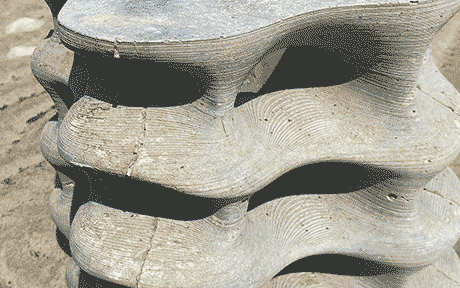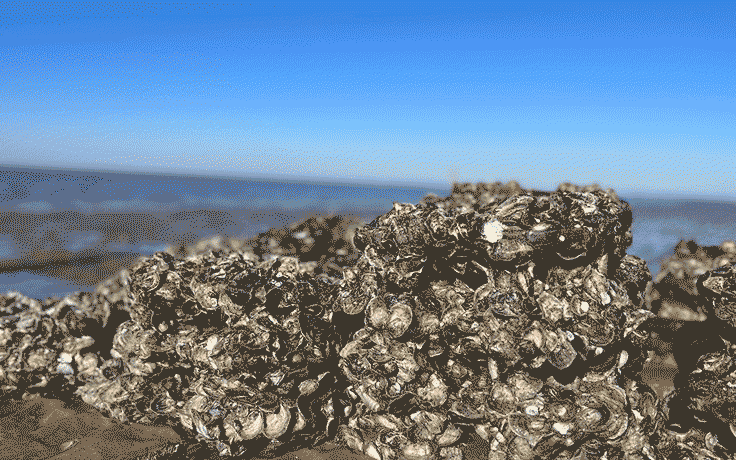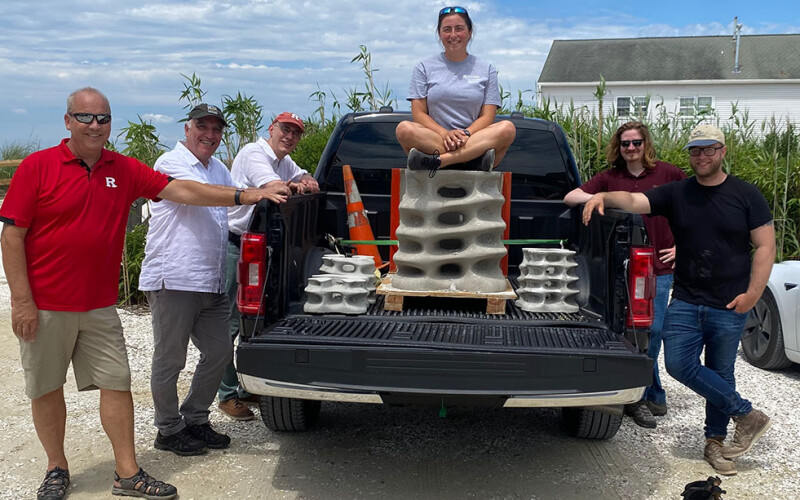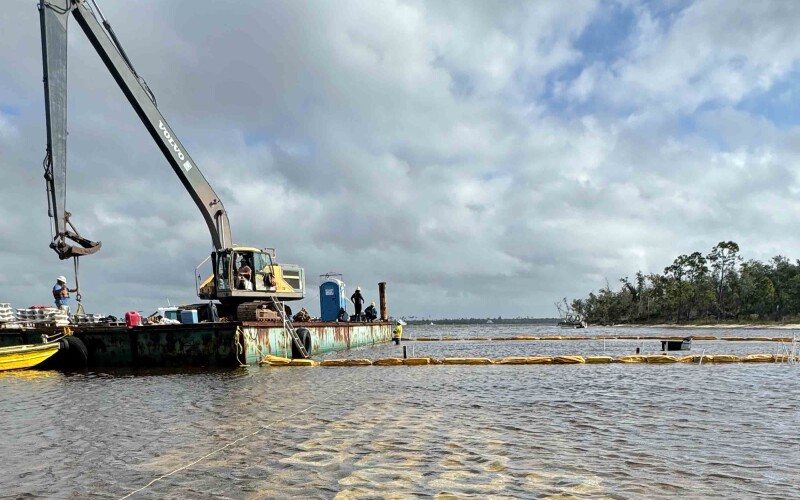An experimental reef structure installed Oct. 30 at an Air Force base in Florida uses interlocking concrete modules and living oysters to protect the base and its people from hurricane and tidal surges.
The project in St. Andrew Bay at Tyndall Air Force Base on the Florida Panhandle is using a “self-healing” reef of concrete modules designed by researchers at Rutgers University. A crane lowered the first segment of what’s planned to be a 160’ wide structure about 200’ offshore, composed of about 800 interconnected concrete cubes that Rutgers scientists created with colleagues collaborating from several institutions.
The concrete provides the kind of hard substrate that oysters will attach to and colonize, and the modules are designed specifically “so that more oysters will naturally gravitate to the structures over the next year, ultimately forming resilient hybrid ‘living’ reefs,” according to a summary by Rutgers officials.
The New Jersey university has long been a center for oyster research through its Haskins Shellfish Research Laboratory on Delaware Bay. Haskins has an international reputation as the oldest and one of the world’s top oyster breeding programs.
The Air Force project is funded through the Reefense program of the Defense Advanced Research Projects Agency (DARPA), to determine whether it can provide adequate defenses against oncoming storms.
It’s an international effort involving more than 60 researchers in the U.S. and Australia, and centers on developing self-healing, hybrid biological and engineered reef-mimicking structures to mitigate coastal flooding, erosion and storm damage.

In October 2018 hurricane Michael came ashore as a category 5 storm, ripping through the Panhandle coast, destroying hangars at Tyndall, damaging aircraft and leaving much of the installation in ruins.
“This experiment will document the Reefense modules’ ability to help protect and enhance the bay shoreline and make it more robust and resilient,” said lead scientist David Bushek, director of the Rutgers Haskin Shellfish Research Laboratory, and a professor in the Department of Marine and Coastal Sciences in the Rutgers School of Environmental and Biological Sciences.
Artificial oyster reefs have already been installed around other military bases, notably Earle Naval Weapons Station in New Jersey, in the southern reaches of the New York-New Jersey Harbor. Earle was hit with about $50 million in damages when hurricane Sandy arrived in late October 2012, and the NY/NJ Baykeeper environmental group worked with the Navy in 2016 to plant an oyster reef off the station’s mile-long ammunition pier.
Naval Station Norfolk in Virginia has oyster structures to help protect from storm surge damage as does Elgin Air Force Reservation in Florida.
Oysters grow in clusters and form natural seawalls in shallow water by attaching to each other. As organic structures, reefs can effectively protect shorelines but can also be broken up themselves during big storms, according to Bushek.

The effort also capitalizes on faculty members’ recent innovations in materials science, hydrodynamic modeling and what scientists refer to as “adaptive biology.” The phrase refers to the ability for organisms to change in response to environmental pressures such as warming temperatures or increasing risks of disease.
Squat and honeycombed, the two-feet-square, 450-pound modules being installed are made of a special engineered, low carbon footprint concrete and will be covered in disease-resistant oysters bred via genomic selection. The structures are expected to stabilize and protect shorelines more effectively than natural oyster reefs.
Holes in the concrete modules are designed to absorb and dissipate wave energy, protecting the shore beneath and the shallow area closer to the shoreline. The structures also force larger waves to break farther out, further protecting the area.
“We wanted to develop an ecologically functional, engineered structure providing the strength and longevity of hard structures while facilitating the benefits provided by organisms colonizing the modules,” said Bushek. “In doing so, we have made a lot of discoveries and advances in science and technology in the past few years. We’ve pushed the needle a lot.”
Bushek is working with Richard Riman, a Distinguished Professor at the Rutgers School of Engineering, who is the project’s co-investigator and is leading the development of the engineered reef. Collaborating Rutgers researchers include Distinguished Professor Ximing Guo and Associate Professor Daphne Munroe, both of the Haskin Laboratory and SEBS, and Hani Nassif, a professor in the School of Engineering.






